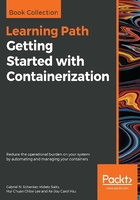
Multistep builds
To demonstrate why a Dockerfile with multiple build steps is useful, let's make an example Dockerfile. Let's take a Hello World application written in C. Here is the code found inside the hello.c file:
#include <stdio.h>
int main (void)
{
printf ("Hello, world!\n");
return 0;
}
Now, we want to containerize this application and write this Dockerfile:
FROM alpine:3.7
RUN apk update &&
apk add --update alpine-sdk
RUN mkdir /app
WORKDIR /app
COPY . /app
RUN mkdir bin
RUN gcc -Wall hello.c -o bin/hello
CMD /app/bin/hello
Now, let's build this image:
$ docker image build -t hello-world .
This gives us a fairly long output, since the builder has to install the Alpine SDK, which, among other tools, contains the C++ compiler we need to build the application.
Once the build is done we can list the image and see its size shown as follows:
$ docker image ls | grep hello-world
hello-world latest e9b... 2 minutes ago 176MB
With a size of 176 MB, the resulting image is way too big. In the end, it is just a Hello World application. The reason for it being so big is that the image not only contains the Hello World binary, but also all the tools to compile and link the application from the source code. But this is really not desirable when running the application, say, in production. Ideally, we only want to have the resulting binary in the image and not a whole SDK.
It is precisely for this reason that we should define Dockerfiles as multistage. We have some stages that are used to build the final artifacts and then a final stage where we use the minimal necessary base image and copy the artifacts into it. This results in very small images. Have a look at this revised Dockerfile:
FROM alpine:3.7 AS build
RUN apk update && \
apk add --update alpine-sdk
RUN mkdir /app
WORKDIR /app
COPY . /app
RUN mkdir bin
RUN gcc hello.c -o bin/hello
FROM alpine:3.7
COPY --from=build /app/bin/hello /app/hello
CMD /app/hello
Here, we have a first stage with an alias build that is used to compile the application, and then the second stage uses the same base image alpine:3.7, but does not install the SDK, and only copies the binary from the build stage, using the --from parameter, into this final image.
Let's build the image again as follows:
$ docker image build -t hello-world-small .
When we compare the sizes of the images, we get the following output:
$ docker image ls | grep hello-world
hello-world-small latest f98... 20 seconds ago 4.16MB
hello-world latest 469... 10 minutes ago 176MB
We have been able to reduce the size from 176 MB down to 4 MB. This is reduction in size by a factor of 40. A smaller image size has many advantages, such as a smaller attack surface area for hackers, reduced memory and disk consumption, faster startup times of the corresponding containers, and a reduction of the bandwidth needed to download the image from a registry, such as Docker Hub.